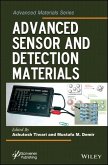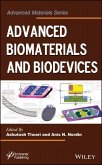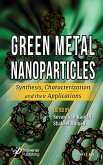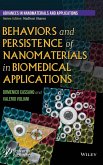Biosensors Nanotechnology
Herausgegeben von Tiwari, Ashutosh; Turner, Anthony P. F.
Biosensors Nanotechnology
Herausgegeben von Tiwari, Ashutosh; Turner, Anthony P. F.
- Gebundenes Buch
- Merkliste
- Auf die Merkliste
- Bewerten Bewerten
- Teilen
- Produkt teilen
- Produkterinnerung
- Produkterinnerung
This book provides detailed reviews of a range of nanostructures used in the construction of biosensors as well as the applications of these biosensor nanotechnologies in the biological, chemical, and environmental monitoring fields
Biological sensing is a fundamental tool for understanding living systems, but also finds practical application in medicine, drug discovery, process control, food safety, environmental monitoring, defense, and personal security. Moreover, a deeper understanding of the bio/electronic interface leads us towards new horizons in areas such as bionics, power…mehr
Andere Kunden interessierten sich auch für
![Advanced Sensor and Detection Materials Advanced Sensor and Detection Materials]() Advanced Sensor and Detection Materials231,99 €
Advanced Sensor and Detection Materials231,99 €![Advanced Biomaterials and Biodevices Advanced Biomaterials and Biodevices]() Advanced Biomaterials and Biodevices227,99 €
Advanced Biomaterials and Biodevices227,99 €![Green Metal Nanoparticles Green Metal Nanoparticles]() Green Metal Nanoparticles290,99 €
Green Metal Nanoparticles290,99 €![Nanomaterials in Clinical Therapeutics Nanomaterials in Clinical Therapeutics]() Nanomaterials in Clinical Therapeutics250,99 €
Nanomaterials in Clinical Therapeutics250,99 €![Behaviors and Persistence of Nanomaterials in Biomedical Applications Behaviors and Persistence of Nanomaterials in Biomedical Applications]() Domenico CassanoBehaviors and Persistence of Nanomaterials in Biomedical Applications212,99 €
Domenico CassanoBehaviors and Persistence of Nanomaterials in Biomedical Applications212,99 €![Advanced Materials for Agriculture, Food, and Environmental Safety Advanced Materials for Agriculture, Food, and Environmental Safety]() Advanced Materials for Agriculture, Food, and Environmental Safety227,99 €
Advanced Materials for Agriculture, Food, and Environmental Safety227,99 €![Non-Volatile Memories Non-Volatile Memories]() Pierre-Camille LacazeNon-Volatile Memories179,99 €
Pierre-Camille LacazeNon-Volatile Memories179,99 €-
-
-
This book provides detailed reviews of a range of nanostructures used in the construction of biosensors as well as the applications of these biosensor nanotechnologies in the biological, chemical, and environmental monitoring fields
Biological sensing is a fundamental tool for understanding living systems, but also finds practical application in medicine, drug discovery, process control, food safety, environmental monitoring, defense, and personal security. Moreover, a deeper understanding of the bio/electronic interface leads us towards new horizons in areas such as bionics, power generation, and computing. Advances in telecommunications, expert systems, and distributed diagnostics prompt us to question the current ways we deliver healthcare, while robust industrial sensors enable new paradigms in R&D and production.
Despite these advances, there is a glaring absence of suitably robust and convenient sensors for body chemistries. This book examines some of the emerging technologies that are fueling scientific discovery and underpinning new products to enhance the length and quality of our lives.
The 14 chapters written by leading experts cover such topics as:
ZnO and graphene microelectrode applications in biosensing
Assembly of polymers/metal nanoparticles
Gold nanoparticle-based electrochemical biosensors
Impedimetric DNA sensing employing nanomaterials
Graphene and carbon nanotube-based biosensors
Computational nanochemistry study of the BFPF green fluorescent protein chromophore
Biosynthesis of metal nanoparticles
Bioconjugated-nanoporous gold films in electrochemical biosensors
The combination of molecular imprinting and nanotechnology
Principles and properties of multiferroics and ceramics
Biological sensing is a fundamental tool for understanding living systems, but also finds practical application in medicine, drug discovery, process control, food safety, environmental monitoring, defense, and personal security. Moreover, a deeper understanding of the bio/electronic interface leads us towards new horizons in areas such as bionics, power generation, and computing. Advances in telecommunications, expert systems, and distributed diagnostics prompt us to question the current ways we deliver healthcare, while robust industrial sensors enable new paradigms in R&D and production.
Despite these advances, there is a glaring absence of suitably robust and convenient sensors for body chemistries. This book examines some of the emerging technologies that are fueling scientific discovery and underpinning new products to enhance the length and quality of our lives.
The 14 chapters written by leading experts cover such topics as:
ZnO and graphene microelectrode applications in biosensing
Assembly of polymers/metal nanoparticles
Gold nanoparticle-based electrochemical biosensors
Impedimetric DNA sensing employing nanomaterials
Graphene and carbon nanotube-based biosensors
Computational nanochemistry study of the BFPF green fluorescent protein chromophore
Biosynthesis of metal nanoparticles
Bioconjugated-nanoporous gold films in electrochemical biosensors
The combination of molecular imprinting and nanotechnology
Principles and properties of multiferroics and ceramics
Produktdetails
- Produktdetails
- Advanced Materials Series
- Verlag: Wiley & Sons
- 1. Auflage
- Seitenzahl: 552
- Erscheinungstermin: 21. Juli 2014
- Englisch
- Abmessung: 236mm x 160mm x 33mm
- Gewicht: 885g
- ISBN-13: 9781118773512
- ISBN-10: 1118773519
- Artikelnr.: 40405519
- Advanced Materials Series
- Verlag: Wiley & Sons
- 1. Auflage
- Seitenzahl: 552
- Erscheinungstermin: 21. Juli 2014
- Englisch
- Abmessung: 236mm x 160mm x 33mm
- Gewicht: 885g
- ISBN-13: 9781118773512
- ISBN-10: 1118773519
- Artikelnr.: 40405519
Ashutosh Tiwari is an Associate Professor at the Biosensors and Bioelectronics Centre, Linköping University, Sweden; Editor-in-Chief, Advanced Materials Letters; Secretary General, International Association of Advanced Materials; a materials chemist and also a docent in applied physics at Linköping University, Sweden. He has published more than 350 articles, patents, and conference proceedings in the field of materials science and technology and has edited/authored more than fifteen books on the advanced state-of-the-art of materials science. He is a founding member of the Advanced Materials World Congress and the Indian Materials Congress. Anthony P.F. Turner is currently Head of Division FM-Linköping University's new Centre for Biosensors and Bioelectronics. His previous thirty-five year academic career in the UK culminated in the positions of Principal (Rector) of Cranfield University and Distinguished Professor of Biotechnology. Professor Turner has more than 600 publications and patents in the field of biosensors and biomimetic sensors and is best known for his role in the development of glucose sensors for home-use by people with diabetes. He published the first textbook on biosensors in 1987 and is Editor-In-Chief of the principal journal in his field, Biosensors & Bioelectronics, which he co-founded in 1985.
Preface xv Part 1: New Materials and Methods 1 1 ZnO and Graphene
Microelectrode Applications in Biosensing 3 Susana Campuzano, María
Pedrero, Georgia-Paraskevi Nikoleli, José M. Pingarron, Dimitrios P.
Nikolelis, Nikolaos Tzamtzis and Vasillios N. Psychoyios 1.1 Biosensors
Based on Nanostructured Materials 4 1.2 Graphene Nanomaterials Used in
ElectrochemicalBiosensor Fabrication 5 1.3 ZnO Nanostructures Used in the
Fabrication of Electrochemical Biosensors 7 1.4 Miniaturized Graphene and
ZnO Nanostructured Electrochemical Biosensors for Food and Clinical
Applications 10 1.5 Conclusions and Future Prospects 30 Acknowledgements 32
References 32 2 Assembly of Polymers/Metal Nanoparticles and Their
Applications as Medical Devices 37 Magdalena Stevanovic 2.1 Introduction 38
2.2 Platinum Nanoparticles 40 2.3 Gold Nanoparticles 41 2.4 Silver
Nanoparticles 44 2.5 Assembly of Polymers/Silver Nanoparticles 45 2.6
Conclusion 51 Acknowledgements 51 References 52 3 Gold Nanoparticle-Based
Electrochemical Biosensors for Medical Applications 63 Ülkü Anik 3.1
Introduction 63 3.2 Gold Nanoparticles 64 3.3 Conclusion 76 References 76 4
Impedimetric DNA Biosensors Based on Nanomaterials 81 Manel del Valle and
Alessandra Bonanni 4.1 Introduction 82 4.2 Electrochemical Impedance
Spectroscopy for Genosensing 85 4.3 Nanostructured Carbon Used in
Impedimetric Genosensors 91 4.4 Nanostructured Gold Used in Impedimetric
Genosensors 97 4.5 Quantum Dots for Impedimetric Genosensing 100 4.6
Impedimetric Genosensors for Point-of-Care Diagnosis 101 4.7 Conclusions
(Past, Present and Future Perspectives) 102 Acknowledgements 104 References
104 5 Graphene: Insights of its Application in Electrochemical Biosensors
for Environmental Monitoring 111 G.A. Álvarez-Romero, G. Alarcon-Angeles
and A. Merkoçi 5.1 Introduction 112 5.2 Environmental Applications of
Graphene-based Biosensors 117 5.3 Conclusions and Perspectives 133
References 134 6 Functional Nanomaterials for Multifarious Nanomedicine 141
Ravindra P. Singh, Jeong-Woo Choi, Ashutosh Tiwari and Avinash Chand Pandey
6.1 Introduction 142 6.2 Nanoparticle Coatings 145 6.3 Cyclic Peptides 147
6.4 Dendrimers 149 6.5 Fullerenes/Carbon Nanotubes/Graphene 156 6.6
Functional Drug Carriers 157 6.7 MRI Scanning Nanoparticles 162 6.8
Nanoemulsions 165 6.9 Nanofibers 166 6.10 Nanoshells 169 6.11 Quantum Dots
171 6.12 Nanoimaging 179 6.13 Inorganic Nanoparticles 180 6.14 Conclusions
182 Acknowledgement 183 References 183 Part 2: Principals and Prospective
199 7 Computational Nanochemistry Study of the Molecular Structure, Spectra
and Chemical Reactivity Properties of the BFPF Green Fluorescent Protein
Chromophore 201 Daniel Glossman-Mitnik 7.1 Introduction 201 7.2 Theory and
Computational Details 202 7.3 Results and Discussion 206 7.4 Conclusions
233 Acknowledgements 234 References 234 8 Biosynthesis of etal
Nanoparticles and Their Applications 239 Meryam Sardar, Abhijeet Mishra and
Razi Ahmad 8.1 Introduction 240 8.2 Synthesis of Metal Nanoparticles 241
8.3 Applications 253 8.4 Conclusions 255 Acknowledgement 256 References 257
9 Ionic Discotic Liquid Crystals: Recent Advances and Applications 267
Santanu Kumar Pal and Sandeep Kumar 9.1 Introduction 268 9.2 Part I:
Chromonic LCs 271 9.3 Part II: Thermotropic Ionic Discotic Liquid Crystals
282 Acknowledgement 309 References 309 10 Role of Advanced Materials as
Nanosensors in Water Treatment 315 Sheenam Thatai, Parul Khurana and Dinesh
Kumar 10.1 Introduction 315 10.2 Nanoparticles 318 10.3 Different
Fabrication Methods of Nanoparticles 319 10.4 Core Material/Nanofillers 321
10.5 Shell Material/Nanomatrix 324 10.6 Core-Shell Material 326 10.7
Properties of Metal Nanoparticles and Core-Shell Nanocomposites 330 10.8
Detection of Heavy Metals Using Smart Core-Shell Nanocomposites 333 10.9
Conclusions 337 Acknowledgement 337 References 338 Part 3: Advanced
Structures and Properties 345 11 Application of Bioconjugated Nanoporous
Gold Films in Electrochemical Biosensors 347 Leila Kashefi-Kheyrabadi,
Abolhassan Noori and Masoud Ayatollahi Mehrgardi 11.1 Introduction 348 11.2
Fabrication of Nanoporous Gold 349 11.3 Nucleic Acids (NAs)-Based
Biosensors 351 11.4 Protein-Nanostructured Gold Bioconjugates in Biosensing
356 11.5 Conclusion 369 References 369 12 Combination of Molecular
Imprinting and Nanotechnology: Beginning of a New Horizon 375 Rashmi
Madhuri, Ekta Roy, Kritika Gupta and Prashant K. Sharma 12.1 Introduction
376 12.2 Classification of Imprinted Nanomaterials 383 12.3 Imprinted
Materials at Nanoscale 421 12.4 Conclusions and Future Outlook 427
Acknowledgements 428 References 428 13 Structural, Electrical and Magnetic
Properties of Pure and Substituted BiFeO3 Multiferroics 433 S. Jangid, S.
K. Barbar and M. Roy 13.1 Introduction 434 13.2 Synthesis of Materials 446
13.3 Structural and Morphological Analyses 454 13.4 Electrical Properties
467 13.5 Magnetic Properties 476 13.6 Thermal Analysis (MDSC Studies) 489
13.7 Summary and Conclusion 496 References 498 14 Synthesis,
Characterization and Rietveld Studies of Sr-modified PZT Ceramics 507 Kumar
Brajesh, A.K. Himanshu and N.K. Singh 14.1 Introduction 508 14.2 Experiment
509 14.3 Rietveld Refinement Details 510 14.4 Results and Discussion 511
14.5 Conclusions 521 References 521 Index 523
Microelectrode Applications in Biosensing 3 Susana Campuzano, María
Pedrero, Georgia-Paraskevi Nikoleli, José M. Pingarron, Dimitrios P.
Nikolelis, Nikolaos Tzamtzis and Vasillios N. Psychoyios 1.1 Biosensors
Based on Nanostructured Materials 4 1.2 Graphene Nanomaterials Used in
ElectrochemicalBiosensor Fabrication 5 1.3 ZnO Nanostructures Used in the
Fabrication of Electrochemical Biosensors 7 1.4 Miniaturized Graphene and
ZnO Nanostructured Electrochemical Biosensors for Food and Clinical
Applications 10 1.5 Conclusions and Future Prospects 30 Acknowledgements 32
References 32 2 Assembly of Polymers/Metal Nanoparticles and Their
Applications as Medical Devices 37 Magdalena Stevanovic 2.1 Introduction 38
2.2 Platinum Nanoparticles 40 2.3 Gold Nanoparticles 41 2.4 Silver
Nanoparticles 44 2.5 Assembly of Polymers/Silver Nanoparticles 45 2.6
Conclusion 51 Acknowledgements 51 References 52 3 Gold Nanoparticle-Based
Electrochemical Biosensors for Medical Applications 63 Ülkü Anik 3.1
Introduction 63 3.2 Gold Nanoparticles 64 3.3 Conclusion 76 References 76 4
Impedimetric DNA Biosensors Based on Nanomaterials 81 Manel del Valle and
Alessandra Bonanni 4.1 Introduction 82 4.2 Electrochemical Impedance
Spectroscopy for Genosensing 85 4.3 Nanostructured Carbon Used in
Impedimetric Genosensors 91 4.4 Nanostructured Gold Used in Impedimetric
Genosensors 97 4.5 Quantum Dots for Impedimetric Genosensing 100 4.6
Impedimetric Genosensors for Point-of-Care Diagnosis 101 4.7 Conclusions
(Past, Present and Future Perspectives) 102 Acknowledgements 104 References
104 5 Graphene: Insights of its Application in Electrochemical Biosensors
for Environmental Monitoring 111 G.A. Álvarez-Romero, G. Alarcon-Angeles
and A. Merkoçi 5.1 Introduction 112 5.2 Environmental Applications of
Graphene-based Biosensors 117 5.3 Conclusions and Perspectives 133
References 134 6 Functional Nanomaterials for Multifarious Nanomedicine 141
Ravindra P. Singh, Jeong-Woo Choi, Ashutosh Tiwari and Avinash Chand Pandey
6.1 Introduction 142 6.2 Nanoparticle Coatings 145 6.3 Cyclic Peptides 147
6.4 Dendrimers 149 6.5 Fullerenes/Carbon Nanotubes/Graphene 156 6.6
Functional Drug Carriers 157 6.7 MRI Scanning Nanoparticles 162 6.8
Nanoemulsions 165 6.9 Nanofibers 166 6.10 Nanoshells 169 6.11 Quantum Dots
171 6.12 Nanoimaging 179 6.13 Inorganic Nanoparticles 180 6.14 Conclusions
182 Acknowledgement 183 References 183 Part 2: Principals and Prospective
199 7 Computational Nanochemistry Study of the Molecular Structure, Spectra
and Chemical Reactivity Properties of the BFPF Green Fluorescent Protein
Chromophore 201 Daniel Glossman-Mitnik 7.1 Introduction 201 7.2 Theory and
Computational Details 202 7.3 Results and Discussion 206 7.4 Conclusions
233 Acknowledgements 234 References 234 8 Biosynthesis of etal
Nanoparticles and Their Applications 239 Meryam Sardar, Abhijeet Mishra and
Razi Ahmad 8.1 Introduction 240 8.2 Synthesis of Metal Nanoparticles 241
8.3 Applications 253 8.4 Conclusions 255 Acknowledgement 256 References 257
9 Ionic Discotic Liquid Crystals: Recent Advances and Applications 267
Santanu Kumar Pal and Sandeep Kumar 9.1 Introduction 268 9.2 Part I:
Chromonic LCs 271 9.3 Part II: Thermotropic Ionic Discotic Liquid Crystals
282 Acknowledgement 309 References 309 10 Role of Advanced Materials as
Nanosensors in Water Treatment 315 Sheenam Thatai, Parul Khurana and Dinesh
Kumar 10.1 Introduction 315 10.2 Nanoparticles 318 10.3 Different
Fabrication Methods of Nanoparticles 319 10.4 Core Material/Nanofillers 321
10.5 Shell Material/Nanomatrix 324 10.6 Core-Shell Material 326 10.7
Properties of Metal Nanoparticles and Core-Shell Nanocomposites 330 10.8
Detection of Heavy Metals Using Smart Core-Shell Nanocomposites 333 10.9
Conclusions 337 Acknowledgement 337 References 338 Part 3: Advanced
Structures and Properties 345 11 Application of Bioconjugated Nanoporous
Gold Films in Electrochemical Biosensors 347 Leila Kashefi-Kheyrabadi,
Abolhassan Noori and Masoud Ayatollahi Mehrgardi 11.1 Introduction 348 11.2
Fabrication of Nanoporous Gold 349 11.3 Nucleic Acids (NAs)-Based
Biosensors 351 11.4 Protein-Nanostructured Gold Bioconjugates in Biosensing
356 11.5 Conclusion 369 References 369 12 Combination of Molecular
Imprinting and Nanotechnology: Beginning of a New Horizon 375 Rashmi
Madhuri, Ekta Roy, Kritika Gupta and Prashant K. Sharma 12.1 Introduction
376 12.2 Classification of Imprinted Nanomaterials 383 12.3 Imprinted
Materials at Nanoscale 421 12.4 Conclusions and Future Outlook 427
Acknowledgements 428 References 428 13 Structural, Electrical and Magnetic
Properties of Pure and Substituted BiFeO3 Multiferroics 433 S. Jangid, S.
K. Barbar and M. Roy 13.1 Introduction 434 13.2 Synthesis of Materials 446
13.3 Structural and Morphological Analyses 454 13.4 Electrical Properties
467 13.5 Magnetic Properties 476 13.6 Thermal Analysis (MDSC Studies) 489
13.7 Summary and Conclusion 496 References 498 14 Synthesis,
Characterization and Rietveld Studies of Sr-modified PZT Ceramics 507 Kumar
Brajesh, A.K. Himanshu and N.K. Singh 14.1 Introduction 508 14.2 Experiment
509 14.3 Rietveld Refinement Details 510 14.4 Results and Discussion 511
14.5 Conclusions 521 References 521 Index 523
Preface xv Part 1: New Materials and Methods 1 1 ZnO and Graphene
Microelectrode Applications in Biosensing 3 Susana Campuzano, María
Pedrero, Georgia-Paraskevi Nikoleli, José M. Pingarron, Dimitrios P.
Nikolelis, Nikolaos Tzamtzis and Vasillios N. Psychoyios 1.1 Biosensors
Based on Nanostructured Materials 4 1.2 Graphene Nanomaterials Used in
ElectrochemicalBiosensor Fabrication 5 1.3 ZnO Nanostructures Used in the
Fabrication of Electrochemical Biosensors 7 1.4 Miniaturized Graphene and
ZnO Nanostructured Electrochemical Biosensors for Food and Clinical
Applications 10 1.5 Conclusions and Future Prospects 30 Acknowledgements 32
References 32 2 Assembly of Polymers/Metal Nanoparticles and Their
Applications as Medical Devices 37 Magdalena Stevanovic 2.1 Introduction 38
2.2 Platinum Nanoparticles 40 2.3 Gold Nanoparticles 41 2.4 Silver
Nanoparticles 44 2.5 Assembly of Polymers/Silver Nanoparticles 45 2.6
Conclusion 51 Acknowledgements 51 References 52 3 Gold Nanoparticle-Based
Electrochemical Biosensors for Medical Applications 63 Ülkü Anik 3.1
Introduction 63 3.2 Gold Nanoparticles 64 3.3 Conclusion 76 References 76 4
Impedimetric DNA Biosensors Based on Nanomaterials 81 Manel del Valle and
Alessandra Bonanni 4.1 Introduction 82 4.2 Electrochemical Impedance
Spectroscopy for Genosensing 85 4.3 Nanostructured Carbon Used in
Impedimetric Genosensors 91 4.4 Nanostructured Gold Used in Impedimetric
Genosensors 97 4.5 Quantum Dots for Impedimetric Genosensing 100 4.6
Impedimetric Genosensors for Point-of-Care Diagnosis 101 4.7 Conclusions
(Past, Present and Future Perspectives) 102 Acknowledgements 104 References
104 5 Graphene: Insights of its Application in Electrochemical Biosensors
for Environmental Monitoring 111 G.A. Álvarez-Romero, G. Alarcon-Angeles
and A. Merkoçi 5.1 Introduction 112 5.2 Environmental Applications of
Graphene-based Biosensors 117 5.3 Conclusions and Perspectives 133
References 134 6 Functional Nanomaterials for Multifarious Nanomedicine 141
Ravindra P. Singh, Jeong-Woo Choi, Ashutosh Tiwari and Avinash Chand Pandey
6.1 Introduction 142 6.2 Nanoparticle Coatings 145 6.3 Cyclic Peptides 147
6.4 Dendrimers 149 6.5 Fullerenes/Carbon Nanotubes/Graphene 156 6.6
Functional Drug Carriers 157 6.7 MRI Scanning Nanoparticles 162 6.8
Nanoemulsions 165 6.9 Nanofibers 166 6.10 Nanoshells 169 6.11 Quantum Dots
171 6.12 Nanoimaging 179 6.13 Inorganic Nanoparticles 180 6.14 Conclusions
182 Acknowledgement 183 References 183 Part 2: Principals and Prospective
199 7 Computational Nanochemistry Study of the Molecular Structure, Spectra
and Chemical Reactivity Properties of the BFPF Green Fluorescent Protein
Chromophore 201 Daniel Glossman-Mitnik 7.1 Introduction 201 7.2 Theory and
Computational Details 202 7.3 Results and Discussion 206 7.4 Conclusions
233 Acknowledgements 234 References 234 8 Biosynthesis of etal
Nanoparticles and Their Applications 239 Meryam Sardar, Abhijeet Mishra and
Razi Ahmad 8.1 Introduction 240 8.2 Synthesis of Metal Nanoparticles 241
8.3 Applications 253 8.4 Conclusions 255 Acknowledgement 256 References 257
9 Ionic Discotic Liquid Crystals: Recent Advances and Applications 267
Santanu Kumar Pal and Sandeep Kumar 9.1 Introduction 268 9.2 Part I:
Chromonic LCs 271 9.3 Part II: Thermotropic Ionic Discotic Liquid Crystals
282 Acknowledgement 309 References 309 10 Role of Advanced Materials as
Nanosensors in Water Treatment 315 Sheenam Thatai, Parul Khurana and Dinesh
Kumar 10.1 Introduction 315 10.2 Nanoparticles 318 10.3 Different
Fabrication Methods of Nanoparticles 319 10.4 Core Material/Nanofillers 321
10.5 Shell Material/Nanomatrix 324 10.6 Core-Shell Material 326 10.7
Properties of Metal Nanoparticles and Core-Shell Nanocomposites 330 10.8
Detection of Heavy Metals Using Smart Core-Shell Nanocomposites 333 10.9
Conclusions 337 Acknowledgement 337 References 338 Part 3: Advanced
Structures and Properties 345 11 Application of Bioconjugated Nanoporous
Gold Films in Electrochemical Biosensors 347 Leila Kashefi-Kheyrabadi,
Abolhassan Noori and Masoud Ayatollahi Mehrgardi 11.1 Introduction 348 11.2
Fabrication of Nanoporous Gold 349 11.3 Nucleic Acids (NAs)-Based
Biosensors 351 11.4 Protein-Nanostructured Gold Bioconjugates in Biosensing
356 11.5 Conclusion 369 References 369 12 Combination of Molecular
Imprinting and Nanotechnology: Beginning of a New Horizon 375 Rashmi
Madhuri, Ekta Roy, Kritika Gupta and Prashant K. Sharma 12.1 Introduction
376 12.2 Classification of Imprinted Nanomaterials 383 12.3 Imprinted
Materials at Nanoscale 421 12.4 Conclusions and Future Outlook 427
Acknowledgements 428 References 428 13 Structural, Electrical and Magnetic
Properties of Pure and Substituted BiFeO3 Multiferroics 433 S. Jangid, S.
K. Barbar and M. Roy 13.1 Introduction 434 13.2 Synthesis of Materials 446
13.3 Structural and Morphological Analyses 454 13.4 Electrical Properties
467 13.5 Magnetic Properties 476 13.6 Thermal Analysis (MDSC Studies) 489
13.7 Summary and Conclusion 496 References 498 14 Synthesis,
Characterization and Rietveld Studies of Sr-modified PZT Ceramics 507 Kumar
Brajesh, A.K. Himanshu and N.K. Singh 14.1 Introduction 508 14.2 Experiment
509 14.3 Rietveld Refinement Details 510 14.4 Results and Discussion 511
14.5 Conclusions 521 References 521 Index 523
Microelectrode Applications in Biosensing 3 Susana Campuzano, María
Pedrero, Georgia-Paraskevi Nikoleli, José M. Pingarron, Dimitrios P.
Nikolelis, Nikolaos Tzamtzis and Vasillios N. Psychoyios 1.1 Biosensors
Based on Nanostructured Materials 4 1.2 Graphene Nanomaterials Used in
ElectrochemicalBiosensor Fabrication 5 1.3 ZnO Nanostructures Used in the
Fabrication of Electrochemical Biosensors 7 1.4 Miniaturized Graphene and
ZnO Nanostructured Electrochemical Biosensors for Food and Clinical
Applications 10 1.5 Conclusions and Future Prospects 30 Acknowledgements 32
References 32 2 Assembly of Polymers/Metal Nanoparticles and Their
Applications as Medical Devices 37 Magdalena Stevanovic 2.1 Introduction 38
2.2 Platinum Nanoparticles 40 2.3 Gold Nanoparticles 41 2.4 Silver
Nanoparticles 44 2.5 Assembly of Polymers/Silver Nanoparticles 45 2.6
Conclusion 51 Acknowledgements 51 References 52 3 Gold Nanoparticle-Based
Electrochemical Biosensors for Medical Applications 63 Ülkü Anik 3.1
Introduction 63 3.2 Gold Nanoparticles 64 3.3 Conclusion 76 References 76 4
Impedimetric DNA Biosensors Based on Nanomaterials 81 Manel del Valle and
Alessandra Bonanni 4.1 Introduction 82 4.2 Electrochemical Impedance
Spectroscopy for Genosensing 85 4.3 Nanostructured Carbon Used in
Impedimetric Genosensors 91 4.4 Nanostructured Gold Used in Impedimetric
Genosensors 97 4.5 Quantum Dots for Impedimetric Genosensing 100 4.6
Impedimetric Genosensors for Point-of-Care Diagnosis 101 4.7 Conclusions
(Past, Present and Future Perspectives) 102 Acknowledgements 104 References
104 5 Graphene: Insights of its Application in Electrochemical Biosensors
for Environmental Monitoring 111 G.A. Álvarez-Romero, G. Alarcon-Angeles
and A. Merkoçi 5.1 Introduction 112 5.2 Environmental Applications of
Graphene-based Biosensors 117 5.3 Conclusions and Perspectives 133
References 134 6 Functional Nanomaterials for Multifarious Nanomedicine 141
Ravindra P. Singh, Jeong-Woo Choi, Ashutosh Tiwari and Avinash Chand Pandey
6.1 Introduction 142 6.2 Nanoparticle Coatings 145 6.3 Cyclic Peptides 147
6.4 Dendrimers 149 6.5 Fullerenes/Carbon Nanotubes/Graphene 156 6.6
Functional Drug Carriers 157 6.7 MRI Scanning Nanoparticles 162 6.8
Nanoemulsions 165 6.9 Nanofibers 166 6.10 Nanoshells 169 6.11 Quantum Dots
171 6.12 Nanoimaging 179 6.13 Inorganic Nanoparticles 180 6.14 Conclusions
182 Acknowledgement 183 References 183 Part 2: Principals and Prospective
199 7 Computational Nanochemistry Study of the Molecular Structure, Spectra
and Chemical Reactivity Properties of the BFPF Green Fluorescent Protein
Chromophore 201 Daniel Glossman-Mitnik 7.1 Introduction 201 7.2 Theory and
Computational Details 202 7.3 Results and Discussion 206 7.4 Conclusions
233 Acknowledgements 234 References 234 8 Biosynthesis of etal
Nanoparticles and Their Applications 239 Meryam Sardar, Abhijeet Mishra and
Razi Ahmad 8.1 Introduction 240 8.2 Synthesis of Metal Nanoparticles 241
8.3 Applications 253 8.4 Conclusions 255 Acknowledgement 256 References 257
9 Ionic Discotic Liquid Crystals: Recent Advances and Applications 267
Santanu Kumar Pal and Sandeep Kumar 9.1 Introduction 268 9.2 Part I:
Chromonic LCs 271 9.3 Part II: Thermotropic Ionic Discotic Liquid Crystals
282 Acknowledgement 309 References 309 10 Role of Advanced Materials as
Nanosensors in Water Treatment 315 Sheenam Thatai, Parul Khurana and Dinesh
Kumar 10.1 Introduction 315 10.2 Nanoparticles 318 10.3 Different
Fabrication Methods of Nanoparticles 319 10.4 Core Material/Nanofillers 321
10.5 Shell Material/Nanomatrix 324 10.6 Core-Shell Material 326 10.7
Properties of Metal Nanoparticles and Core-Shell Nanocomposites 330 10.8
Detection of Heavy Metals Using Smart Core-Shell Nanocomposites 333 10.9
Conclusions 337 Acknowledgement 337 References 338 Part 3: Advanced
Structures and Properties 345 11 Application of Bioconjugated Nanoporous
Gold Films in Electrochemical Biosensors 347 Leila Kashefi-Kheyrabadi,
Abolhassan Noori and Masoud Ayatollahi Mehrgardi 11.1 Introduction 348 11.2
Fabrication of Nanoporous Gold 349 11.3 Nucleic Acids (NAs)-Based
Biosensors 351 11.4 Protein-Nanostructured Gold Bioconjugates in Biosensing
356 11.5 Conclusion 369 References 369 12 Combination of Molecular
Imprinting and Nanotechnology: Beginning of a New Horizon 375 Rashmi
Madhuri, Ekta Roy, Kritika Gupta and Prashant K. Sharma 12.1 Introduction
376 12.2 Classification of Imprinted Nanomaterials 383 12.3 Imprinted
Materials at Nanoscale 421 12.4 Conclusions and Future Outlook 427
Acknowledgements 428 References 428 13 Structural, Electrical and Magnetic
Properties of Pure and Substituted BiFeO3 Multiferroics 433 S. Jangid, S.
K. Barbar and M. Roy 13.1 Introduction 434 13.2 Synthesis of Materials 446
13.3 Structural and Morphological Analyses 454 13.4 Electrical Properties
467 13.5 Magnetic Properties 476 13.6 Thermal Analysis (MDSC Studies) 489
13.7 Summary and Conclusion 496 References 498 14 Synthesis,
Characterization and Rietveld Studies of Sr-modified PZT Ceramics 507 Kumar
Brajesh, A.K. Himanshu and N.K. Singh 14.1 Introduction 508 14.2 Experiment
509 14.3 Rietveld Refinement Details 510 14.4 Results and Discussion 511
14.5 Conclusions 521 References 521 Index 523








